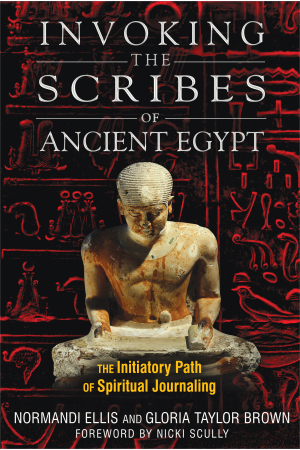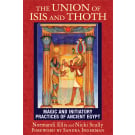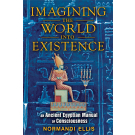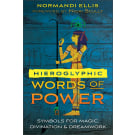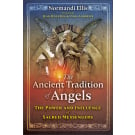Invoking the Scribes of Ancient Egypt
The Initiatory Path of Spiritual Journaling
Availability:
In Stock
- Pages: 336
- Book Size: 6 x 9
- ISBN-13: 9781591431282
- Imprint: Bear & Company
- On Sale Date: October 28, 2011
- Format: Paperback Book
- Illustrations: 70 b&w illustrations
The scribes of ancient Egypt were masters of hieroglyphic thinking, which gave them the power to create worlds through their words. This book shows that by writing like scribes we can give our dreams form and recognize our life's purpose.
Tools to powerfully write about and manifest your life using the power found in the sacred sites of ancient Egypt
• Reveals how to create meaning from one’s life experiences and manifest new destinies through spiritual writing
• Contains meditations and creative writing exercises exploring sacred themes in the Egyptian Book of the Dead and other hieroglyphic texts of ancient Egypt
• Shares transformative and inspiring pieces written by those who’ve attended the authors’ Egyptian sacred tours
Within each of us is a story, a sacred story that needs to be told, of our heroic efforts and of our losses. The scribes of ancient Egypt devoted their lives to the writing of sacred stories. These technicians of the sacred were masters of hieroglyphic thinking, or heka--the proper words, in the proper sequence, with the proper intonation and the proper intent. Learning heka provided scribes with the power to invoke and create worlds through their words and thoughts. To the writer, heka is a magical way to create meaning from experience. Through heka we manifest new visions and new relationships to ourselves and to others. We can make new art filled with beauty and light.
Revealing the spiritually transformative power of writing, the authors take us on a journey of self-discovery through the sacred sites of Egypt, from the Temple of Isis to the Great Pyramid of Giza. Through meditations and creative writing exercises exploring the powerful themes found in the hieroglyphic texts of ancient Egypt and the Egyptian Book of the Dead, they show how, through writing, we can live beyond the ordinary, give our dreams form, and discover who we really are and what our lives really mean. Sharing transformative and inspiring pieces written by those who’ve attended their Egyptian sacred tours, the authors reveal how writing your spiritual biography allows you to reconnect to the creativity and divine within, face your fears, offer gratitude for what you have, manifest new destinies, and recognize your life as part of the sacred story of Earth.
• Reveals how to create meaning from one’s life experiences and manifest new destinies through spiritual writing
• Contains meditations and creative writing exercises exploring sacred themes in the Egyptian Book of the Dead and other hieroglyphic texts of ancient Egypt
• Shares transformative and inspiring pieces written by those who’ve attended the authors’ Egyptian sacred tours
Within each of us is a story, a sacred story that needs to be told, of our heroic efforts and of our losses. The scribes of ancient Egypt devoted their lives to the writing of sacred stories. These technicians of the sacred were masters of hieroglyphic thinking, or heka--the proper words, in the proper sequence, with the proper intonation and the proper intent. Learning heka provided scribes with the power to invoke and create worlds through their words and thoughts. To the writer, heka is a magical way to create meaning from experience. Through heka we manifest new visions and new relationships to ourselves and to others. We can make new art filled with beauty and light.
Revealing the spiritually transformative power of writing, the authors take us on a journey of self-discovery through the sacred sites of Egypt, from the Temple of Isis to the Great Pyramid of Giza. Through meditations and creative writing exercises exploring the powerful themes found in the hieroglyphic texts of ancient Egypt and the Egyptian Book of the Dead, they show how, through writing, we can live beyond the ordinary, give our dreams form, and discover who we really are and what our lives really mean. Sharing transformative and inspiring pieces written by those who’ve attended their Egyptian sacred tours, the authors reveal how writing your spiritual biography allows you to reconnect to the creativity and divine within, face your fears, offer gratitude for what you have, manifest new destinies, and recognize your life as part of the sacred story of Earth.
Day 7
Temple of Osiris - Abydos and Temple of Hathor - Dendera
The Art of Beauty and Grace
Unlike other temples of Egypt, the Temple of Hathor at Dendera presents an open face, with a clear view of the hypostyle hall to the viewer. No great pylons shield the entry, no scene of battle splash across its walls. Instead, a small mammisi, or birthing chamber, sits at the entrance, and a sanatorium is located beyond the mammisi. As pilgrims approach the temple, they arrive in a hypostyle hall of massive columns with the face of the goddess Hathor at the top of each column. Long ago the gold face masks were taken down, but the beauty of the Lady of Turquoise is being reborn as the archaeological restorations carefully remove centuries of dirt and smoke to reveal the original colors.
On the ceiling the much celebrated zodiac of Dendera appears; a replica of the original, which is now located at the Louvre in France. Built upon earlier structures, Dendera as the pilgrim sees it now is almost entirely constructed after the Greeks had assumed rule of Egypt. On the walls, portraits of Cleopatra, Ceasarion, and other Roman rulers abound.
This temple was the home of Hathor, where the statue of the goddess lived most of the year. She traveled annually to Edfu to meet with her consort, Horus. Her name is derived from this connection, meaning “the house of Horus.”
By night the temple takes on a magical air, and the roof leads to the stars.
A Thousand Beautiful Things
For years I have kept a gratitude journal, and it reminds me of all the power of the universe to create synchronicities, and beauty, and mistakes that eventually create lessons and meaning. I am grateful even when some days one of the things I had to be grateful for was the ability to simply get out of bed. And when I did, there was the cardinal at the window.
From the first time Gloria and I set foot in Egypt we felt in awe at the color, at the miracles of its architecture, at its sounds, its food, and the everyday around-the-corner amazements. There is much to love: the granite boulders hump-backed like elephants, the sunlight slanting over the cane fields and illuminating the cliffs of Qena at dawn. Inside the cacophony of car horns, Cairo traffic flows around donkey carts, pedestrians and camels while pyramids loom out of the desert surrounded by infinitude of stars.
Our lady of Dendera, Hathor, holds a beatific smile while she seems to balance upon her head the weight of the temple and the zodiac of the entire sky. In just that way Egyptian women walk gracefully through town dodging goats and children, carrying baskets of food on their heads. Hathor’s grace and love kept this band of travelers focused on the beauty around us. Overheated from walking through two temples in the blazing sun and overtired from having risen before dawn to catch our bus, still we found a thousand things for which to be grateful.
Keeping a Gratitude Journal
Keeping a gratitude journal helps us to stay aware of the beauty that surrounds us daily. It behooves us to stop in the middle of a day and record what we see that strikes us as a blessing, a stunning visual, a strain of music, a helpful gesture. At the end of the day, record five things. If you recorded 5 gratitudes for 365 days you would have written 1,825 beautiful things.
Our lives are filled with lists--shopping lists, to-do lists, roll calls, appointments, etc. The list of beautiful things tell us about the spiritual things that matter, what feeds our souls, what is not ours to do but simply ours to accept.
The trick is to stay awake. Try not to repeat the same line. Find more than five beautiful things every day. Try to find beauty in the things that did not seem beautiful at the time. Like the policeman who stopped you on the highway because your tags were expired. Be grateful that Divine Spirit watches over us, teaching us patience, keeping us out of harm’s way, reminding us that the little things matter and we need to slow down and pay attention to details.
In finding abundant blessings in the life we are living, abundant blessings continue to follow us. With an attitude of gratitude, we create more abundance and our lives seem continually blessed by the love that surrounds us. Begin your list now.
This Is Mine to Remember
Nicki Scully
Stab of sunlight on a hieroglyph in the hypostyle hall, calling my name, remembering me. I give thanks for magic--the lifting of the veil to glimpse ancient secrets and commune with gods in the temples.
This is mine to remember.
My greatest burden lifted in a surprise, tear-filled moment of ma’at in the Holy of Holies at Edfu.
This is mine to remember. My daughter’s face glowing with life and love, filling the world with laughter that shook her free of cancer.
My husband’s eyes seen in a vision, months before we met.
A child headed for surgery struck by a lightning bolt from Thoth, healed to become a healer.
The magic, moonless night in the garden, overwhelmed by the fragrance of blossoms crowning stalks that shimmered in the starlit breeze above my head.
These are mine to remember.
My firstborn’s eyes wide open to the world while her body was still in my womb
Sea turtles copulating in the frothy swells open to gift me with their fertile consummation, the conception of a life’s work.
Glistening fractal spirals carrying me into the wondrous beauty of rebirth--again and again.
I am a daughter of Hathor. Grateful is my name. This is mine to remember.
Temple of Osiris - Abydos and Temple of Hathor - Dendera
The Art of Beauty and Grace
Unlike other temples of Egypt, the Temple of Hathor at Dendera presents an open face, with a clear view of the hypostyle hall to the viewer. No great pylons shield the entry, no scene of battle splash across its walls. Instead, a small mammisi, or birthing chamber, sits at the entrance, and a sanatorium is located beyond the mammisi. As pilgrims approach the temple, they arrive in a hypostyle hall of massive columns with the face of the goddess Hathor at the top of each column. Long ago the gold face masks were taken down, but the beauty of the Lady of Turquoise is being reborn as the archaeological restorations carefully remove centuries of dirt and smoke to reveal the original colors.
On the ceiling the much celebrated zodiac of Dendera appears; a replica of the original, which is now located at the Louvre in France. Built upon earlier structures, Dendera as the pilgrim sees it now is almost entirely constructed after the Greeks had assumed rule of Egypt. On the walls, portraits of Cleopatra, Ceasarion, and other Roman rulers abound.
This temple was the home of Hathor, where the statue of the goddess lived most of the year. She traveled annually to Edfu to meet with her consort, Horus. Her name is derived from this connection, meaning “the house of Horus.”
By night the temple takes on a magical air, and the roof leads to the stars.
A Thousand Beautiful Things
For years I have kept a gratitude journal, and it reminds me of all the power of the universe to create synchronicities, and beauty, and mistakes that eventually create lessons and meaning. I am grateful even when some days one of the things I had to be grateful for was the ability to simply get out of bed. And when I did, there was the cardinal at the window.
From the first time Gloria and I set foot in Egypt we felt in awe at the color, at the miracles of its architecture, at its sounds, its food, and the everyday around-the-corner amazements. There is much to love: the granite boulders hump-backed like elephants, the sunlight slanting over the cane fields and illuminating the cliffs of Qena at dawn. Inside the cacophony of car horns, Cairo traffic flows around donkey carts, pedestrians and camels while pyramids loom out of the desert surrounded by infinitude of stars.
Our lady of Dendera, Hathor, holds a beatific smile while she seems to balance upon her head the weight of the temple and the zodiac of the entire sky. In just that way Egyptian women walk gracefully through town dodging goats and children, carrying baskets of food on their heads. Hathor’s grace and love kept this band of travelers focused on the beauty around us. Overheated from walking through two temples in the blazing sun and overtired from having risen before dawn to catch our bus, still we found a thousand things for which to be grateful.
Keeping a Gratitude Journal
Keeping a gratitude journal helps us to stay aware of the beauty that surrounds us daily. It behooves us to stop in the middle of a day and record what we see that strikes us as a blessing, a stunning visual, a strain of music, a helpful gesture. At the end of the day, record five things. If you recorded 5 gratitudes for 365 days you would have written 1,825 beautiful things.
Our lives are filled with lists--shopping lists, to-do lists, roll calls, appointments, etc. The list of beautiful things tell us about the spiritual things that matter, what feeds our souls, what is not ours to do but simply ours to accept.
The trick is to stay awake. Try not to repeat the same line. Find more than five beautiful things every day. Try to find beauty in the things that did not seem beautiful at the time. Like the policeman who stopped you on the highway because your tags were expired. Be grateful that Divine Spirit watches over us, teaching us patience, keeping us out of harm’s way, reminding us that the little things matter and we need to slow down and pay attention to details.
In finding abundant blessings in the life we are living, abundant blessings continue to follow us. With an attitude of gratitude, we create more abundance and our lives seem continually blessed by the love that surrounds us. Begin your list now.
This Is Mine to Remember
Nicki Scully
Stab of sunlight on a hieroglyph in the hypostyle hall, calling my name, remembering me. I give thanks for magic--the lifting of the veil to glimpse ancient secrets and commune with gods in the temples.
This is mine to remember.
My greatest burden lifted in a surprise, tear-filled moment of ma’at in the Holy of Holies at Edfu.
This is mine to remember. My daughter’s face glowing with life and love, filling the world with laughter that shook her free of cancer.
My husband’s eyes seen in a vision, months before we met.
A child headed for surgery struck by a lightning bolt from Thoth, healed to become a healer.
The magic, moonless night in the garden, overwhelmed by the fragrance of blossoms crowning stalks that shimmered in the starlit breeze above my head.
These are mine to remember.
My firstborn’s eyes wide open to the world while her body was still in my womb
Sea turtles copulating in the frothy swells open to gift me with their fertile consummation, the conception of a life’s work.
Glistening fractal spirals carrying me into the wondrous beauty of rebirth--again and again.
I am a daughter of Hathor. Grateful is my name. This is mine to remember.
Foreword by Nicki Scully
Acknowledgments
Introduction: Why Spiritual Autobiography Matters
Day 1 Cairo: Before the Tour
Includes writings by Mark Hallert, Kathryn Ravenwood, and Pat Chesser
Exercise: The Personal Universe Exercise
Day 2 The Great Sphinx at Giza
Includes writings by Margaret Kachadurian, Kathryn Ravenwood, Joyce Brady, and Piliaka Peter
Exercise: Writing about Your Hero’s Journey
Day 3 The Temple of Khnum at Aswan
Includes writings by Meri Arnett-Kremian, Mark Hallert, Jane Wodening, and Vera Kaplan
Exercise: Writing the Stepping-Stones
Day 4 Part I--The Temple of Isis at Philae
Includes writings by Jane Wodening, Denise Adaya Marcel, Pat Chesser, and Vera Kaplan
Exercise: Writing the “I Am Isis” Aretalogy
Day 4 Part II--The Temple of Horus and Sobek at Kom Ombo
Includes writings by Nettie Eldredge, Jane Wodening, Denise Adaya Marcel, and Meri Arnett-Kremian
Exercise: Writing about Fear
Day 5 The Temple of Horus at Edfu
Includes writings by Donna Swindells, Barbara Lindsey, Margaret Kachadurian, Vera Kaplan, Joyce Brady, Kathryn Ravenwood, Mark Hallert, and Nettie Eldredge
Exercise: A Glimmer of Future Destinies
Exercise: Writing the “Becoming” Poem
Exercise: Writing the “I Am” Poem
Day 6 The Temple of Khnum and Neith at Esna
Includes writings by Meri Arnett-Kremian, Joyce Brady, Alma Donato, and Nicki Scully
Exercise: Write about Something You Don’t Understand
Day 7 Part I--The Temple of Osiris at Abydos
Includes writings by Barbara Lindsey, Pat Chesser, and Kathryn Ravenwood
Exercise: Dream a Little Dream
Day 7 Part II--The Temple of Hathor at Dendera
Includes writings by Kathryn Ravenwood, Nicki Scully, Pat Chesser, Laura Janesdaughter, and Piliaka Peter
Exercise: Keeping a Gratitude Journal
Day 8 Part I--The Temple of Ptah at Luxor
Includes writings by Kathryn Ravenwood, Cathleen Shattuck, Laura Janesdaughter, and Nettie Eldredge
Exercise: Dialogue with the Divine
Day 8 Part II--Karnak Temple at Luxor
Includes writings by Alma Donato, Donna Swindells, Joyce Brady, Mark Hallert, and Kathryn Ravenwood
Exercise: Poetry Cube Exercise
Day 9 Part I--The Temple of Hatshepsut at Deir el Bahari
Includes writings by Joyce Brady, Cathleen Shattuck, and Denise Adaya Marcel
Exercise: Naming Oneself and Aligning with the Ancestors
Day 9 Part II--The Valley of the Kings at Western Thebes
Includes writings by Laura Janes daughter, Mark Hallert, Nettie Eldredge, and Joyce Brady
Exercise: Name Your Barrier
Day 10 The Luxor Temple at Luxor
Includes writings by Nettie Eldredge and Vera Kaplan
Exercise: Exploring and Writing about the Spiritual Bodies
Day 11 Travel Day: Luxor to Cairo
Includes writings by Meri Arnett-Kremian, Denise Adaya Marcel, Nicki Scully, Cathleen Shattuck, and Vera Kaplan
Exercise: 3-2-4-1 Exercise
Day 12 The Pyramids of Djoser and Unas at Saqqara
Includes writings by Laura Janesdaughter, Piliaka Peter, and Jane Wodening
Exercise: Writing “I Remember” Poems
Day 13 The Great Pyramid at Giza
Includes writings by Piliaka Peter, Meri Arnett-Kremian, and Nettie Eldredge
Exercise: Reviewing the Journey Poem or Myth
Day 14 Leaving Egypt: Cairo to Home
Includes writings by Joyce Brady, Pat Chesser, Cathleen Shattuck, Alma Donato, and Kathryn Ravenwood
Exercise: Writing a Letter to Yourself
Biographies of the Sacred Travelers
Bibliography
Index
Normandi Ellis is an award-winning writer, workshop facilitator, and director of PenHouse Retreat Center. The author of several books, including Awakening Osiris, she lives in Frankfort, Kentucky. Gloria Taylor Brown is a university lecturer, Alchemical Healing teacher, and recognized mystic and visionary. A lifelong student of Egyptian studies, she is the president of Alchemy Arts, Inc. She lives in San Diego, California.
“This book is especially powerful for those of us who love to write and have the hidden content come through beyond the words. Many secrets lie hidden in plain sight simply because we do not have the eyes to see the deeper meaning. This may help open your eyes.”
Rahasya Poe, Lotus Guide, January 2012
“The authors balance well between the personal and the spiritual. While the women on the tour happened to have the means to tour Egypt for themselves, a reader at home who might not visit Egypt can still use the writing exercises, rituals and techniques shared at much lower cost than the airfare to Cairo. Recommended.”
Diana Rajchel, Facing North
“This isn’t a book that you will just read through once and then put it away on your bookshelf to gather dust. This is book you will savor as you read. This is a book that will, if you open yourself to the experience (as I heartily recommend!), connect you with a universe that is so much larger than you may have imagined. You will find that your “inner scribe” is much more than just a “journaler” who makes quick notes about your daily life or responds to various off-the-cuff prompts. This is spiritual journaling, an oh-so-different beast...I highly recommend that you take the opportunity to refresh your soul with Invoking the Scribes of Ancient Egypt: The Initiatory Path of Spiritual Journaling!”
Journal For You April 2012
“I recommend this book for anyone who would like to see Egypt through a writer’s passionate gaze or as a guide for looking into the journey of spiritual writing regardless of your path. This book is an excellent guide for basic layouts for writing and as such I will continue to work with. The writers share some deep and truly beautiful insights into the land of the Scribes of Egypt. Come join them, take a beautiful journey and then embark upon your own Spiritual Initiatory Journaling experience.”
Henge of Keltria, June 2012
“I recommend this book on three counts. Firstly, it is an example of modern travel writing; secondly, an anthology of spiritual poetry and prose; and finally, as a handbook for spiritual development. The structure of the whole venture is flexible enough to adapt to any spiritual stream. Go for it!”
Jennifer Hoskins, New Dawn, September 2012
“Invoking the Scribes of Ancient Egypt is a book of wisdom that includes the writing exercises, perceptive comments on the temples and gods and goddesses, guided meditations, and even remarks about the heat and how the life of modern Egypt overlies the older civilization. It should have a place on our shelves beside the other fine books on spiritual journaling, including those by Julia Cameron.”
Barbara Ardinger, Ph.D., Witches and Pagans, October 2012
“It’s not often that ancient Egypt inspires a truly original work, but this is one of those rarities. A passionate, moving, intensely personal and yet remarkably informative book; there’s nothing remotely like it.”
John Anthony West, author of Serpent in the Sky and The Traveler’s Key to Ancient Egypt
Rahasya Poe, Lotus Guide, January 2012
“The authors balance well between the personal and the spiritual. While the women on the tour happened to have the means to tour Egypt for themselves, a reader at home who might not visit Egypt can still use the writing exercises, rituals and techniques shared at much lower cost than the airfare to Cairo. Recommended.”
Diana Rajchel, Facing North
“This isn’t a book that you will just read through once and then put it away on your bookshelf to gather dust. This is book you will savor as you read. This is a book that will, if you open yourself to the experience (as I heartily recommend!), connect you with a universe that is so much larger than you may have imagined. You will find that your “inner scribe” is much more than just a “journaler” who makes quick notes about your daily life or responds to various off-the-cuff prompts. This is spiritual journaling, an oh-so-different beast...I highly recommend that you take the opportunity to refresh your soul with Invoking the Scribes of Ancient Egypt: The Initiatory Path of Spiritual Journaling!”
Journal For You April 2012
“I recommend this book for anyone who would like to see Egypt through a writer’s passionate gaze or as a guide for looking into the journey of spiritual writing regardless of your path. This book is an excellent guide for basic layouts for writing and as such I will continue to work with. The writers share some deep and truly beautiful insights into the land of the Scribes of Egypt. Come join them, take a beautiful journey and then embark upon your own Spiritual Initiatory Journaling experience.”
Henge of Keltria, June 2012
“I recommend this book on three counts. Firstly, it is an example of modern travel writing; secondly, an anthology of spiritual poetry and prose; and finally, as a handbook for spiritual development. The structure of the whole venture is flexible enough to adapt to any spiritual stream. Go for it!”
Jennifer Hoskins, New Dawn, September 2012
“Invoking the Scribes of Ancient Egypt is a book of wisdom that includes the writing exercises, perceptive comments on the temples and gods and goddesses, guided meditations, and even remarks about the heat and how the life of modern Egypt overlies the older civilization. It should have a place on our shelves beside the other fine books on spiritual journaling, including those by Julia Cameron.”
Barbara Ardinger, Ph.D., Witches and Pagans, October 2012
“It’s not often that ancient Egypt inspires a truly original work, but this is one of those rarities. A passionate, moving, intensely personal and yet remarkably informative book; there’s nothing remotely like it.”
John Anthony West, author of Serpent in the Sky and The Traveler’s Key to Ancient Egypt
SPIRITUALITY / SELF-HELP
“It’s not often that ancient Egypt inspires a truly original work, but this is one of those rarities. A passionate, moving, intensely personal and yet remarkably informative book; there’s nothing remotely like it.”
--John Anthony West, author of Serpent in the Sky and The Traveler’s Key to Ancient Egypt
Within each of us is a story, a sacred story that needs to be told, of our heroic efforts and of our losses. The scribes of ancient Egypt devoted their lives to the writing of sacred stories. These technicians of the sacred were masters of hieroglyphic thinking, or heka--the proper words, in the proper sequence, with the proper intonation and the proper intent. Learning heka provided scribes with the power to invoke and create worlds through their words and thoughts. To the writer, heka is a magical way to create meaning from experience. Through heka we manifest new visions and new relationships to ourselves and to others. We can make new art filled with beauty and light.
Revealing the spiritually transformative power of writing, the authors take us on a journey of self-discovery through the sacred sites of Egypt, from the Temple of Isis to the Great Pyramid of Giza. Through meditations and creative writing exercises exploring the powerful themes found in the hieroglyphic texts of ancient Egypt and the Egyptian Book of the Dead, they show how, through writing, we can live beyond the ordinary, give our dreams form, and discover who we really are and what our lives really mean. Sharing transformative and inspiring pieces written by those who’ve attended their Egyptian sacred tours, the authors reveal how writing your spiritual biography allows you to reconnect to the creativity and divine within, face your fears, offer gratitude for what you have, manifest new destinies, and recognize your life as part of the sacred story of Earth.
NORMANDI ELLIS is an award-winning writer, workshop facilitator, and director of PenHouse Retreat Center. The author of several books, including Awakening Osiris, she lives in Frankfort, Kentucky. GLORIA TAYLOR BROWN is a university lecturer, Alchemical Healing teacher, and recognized mystic and visionary. A lifelong student of Egyptian studies, she is the president of Alchemy Arts, Inc. She lives in San Diego, California.
“It’s not often that ancient Egypt inspires a truly original work, but this is one of those rarities. A passionate, moving, intensely personal and yet remarkably informative book; there’s nothing remotely like it.”
--John Anthony West, author of Serpent in the Sky and The Traveler’s Key to Ancient Egypt
Within each of us is a story, a sacred story that needs to be told, of our heroic efforts and of our losses. The scribes of ancient Egypt devoted their lives to the writing of sacred stories. These technicians of the sacred were masters of hieroglyphic thinking, or heka--the proper words, in the proper sequence, with the proper intonation and the proper intent. Learning heka provided scribes with the power to invoke and create worlds through their words and thoughts. To the writer, heka is a magical way to create meaning from experience. Through heka we manifest new visions and new relationships to ourselves and to others. We can make new art filled with beauty and light.
Revealing the spiritually transformative power of writing, the authors take us on a journey of self-discovery through the sacred sites of Egypt, from the Temple of Isis to the Great Pyramid of Giza. Through meditations and creative writing exercises exploring the powerful themes found in the hieroglyphic texts of ancient Egypt and the Egyptian Book of the Dead, they show how, through writing, we can live beyond the ordinary, give our dreams form, and discover who we really are and what our lives really mean. Sharing transformative and inspiring pieces written by those who’ve attended their Egyptian sacred tours, the authors reveal how writing your spiritual biography allows you to reconnect to the creativity and divine within, face your fears, offer gratitude for what you have, manifest new destinies, and recognize your life as part of the sacred story of Earth.
NORMANDI ELLIS is an award-winning writer, workshop facilitator, and director of PenHouse Retreat Center. The author of several books, including Awakening Osiris, she lives in Frankfort, Kentucky. GLORIA TAYLOR BROWN is a university lecturer, Alchemical Healing teacher, and recognized mystic and visionary. A lifelong student of Egyptian studies, she is the president of Alchemy Arts, Inc. She lives in San Diego, California.



